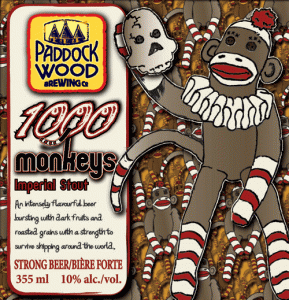 I have been brewing for more than 20 years now, and I have attempted to brew almost every style under the sun (at least that don’t involve wild yeasts or bacteria such as lambics and Flanders Reds and Browns – I have always been afraid of contaminating my homebrewery). But one style I have never gotten around to doing is Russian Imperial Stout. Not sure why, to be honest. I am a big fan of the style and my brewery does seem to perform well with stouts (having won many medals for my Oatmeal Stout). Almost every year as I plan out my brew schedule, it makes the first draft as I say to myself “THIS is the year I take a crack at it”. But then somehow every year it gets cut at the last second, overtaken by a hankering for my oatmeal stout or substituted for a quicker beer due to dwindling stocks. Of course, as tradition has it, an RIS is on my 2012 plan for the moment. We will see if it survives.
I have been brewing for more than 20 years now, and I have attempted to brew almost every style under the sun (at least that don’t involve wild yeasts or bacteria such as lambics and Flanders Reds and Browns – I have always been afraid of contaminating my homebrewery). But one style I have never gotten around to doing is Russian Imperial Stout. Not sure why, to be honest. I am a big fan of the style and my brewery does seem to perform well with stouts (having won many medals for my Oatmeal Stout). Almost every year as I plan out my brew schedule, it makes the first draft as I say to myself “THIS is the year I take a crack at it”. But then somehow every year it gets cut at the last second, overtaken by a hankering for my oatmeal stout or substituted for a quicker beer due to dwindling stocks. Of course, as tradition has it, an RIS is on my 2012 plan for the moment. We will see if it survives.
I think I want to make up for my snubbing of such a fine beer by talking about it a lot. Russian Imperials often make my beer tasting event lists. Last year it topped off my 3-part series on stouts (see my post on it here), and in the current issue of Planet S(which you can read here), I introduce the beer style to Saskatchewan denizens through the release of Paddock Wood’s 1000 Monkeys.
I always like a beer with a good back story – some kind of rich history or a great personal tale about its creation. The origins of RIS are intertwined with 18th century politics and trade, and so has a particular attraction to me. In the Planet S feature I briefly summarize the history, and then shift to a review of 1000 Monkeys.
The other reason I love RIS is because it is necessarily huge and challenging, but that you can’t just toss a bunch of malt in and brew it up. It takes far more finesse than its colour, alcohol content and heft suggest. It takes a careful approach to design and execution, as there are many places where things can go wrong with such a massive beer. It can easily end up too thin, too roasted, too sweet, too sour or any other possible “toos”. Doing some element of an RIS too much is very easy. Plus, the damned thing needs to age well, meaning as the sherry notes build they should add complexity, not detract.
Now that I think of it, maybe that is why I am quick to drop it from my brew list. It is just a little intimidating for a guy who gets to brew up only 6-8 batches a year. Nah! That’s not it. I have tried barley wine and old ales a few times, which can also be quite exacting, so clearly that isn’t it.
I wonder what it will take to finally push me over the edge on this? Maybe another glass of 1000 Monkeys will help me figure it out.


February 29, 2012 at 10:39 AM
I haven’t tried the new batch of 1000 Monkeys yet, but the batch released last summer was spectacular, easily the best Canadian Imperial Stout I have tasted.
I am the opposite of you Jason, I brew a lot of imperial stouts, and lots of funky beers too. Just kegged a RIS 2 days ago that had been sitting on Brett L and Brett C for 8 months. Came in just under 11% and the brett didn’t chew up too much of the body. Much better than the Brett RIS I brewed in 09, which won BOS at the 2010 Calgary Comp.
February 29, 2012 at 11:07 AM
Coming from you Mark, those are hefty words about the quality of 1000 Monkeys. I imagine Stephen at Paddock Wood is blushing at the moment.
February 29, 2012 at 12:19 PM
A few friends are getting together for a “Super Stout” tasting in a few weeks, minimum ABV is 10%.
I’m hoping 1000 Monkeys gets included in the final lineup, will be interesting how it compares. Will report back.
February 29, 2012 at 1:49 PM
It’s on tap at the Wunderbar, had it last week, it was a very satisfying pint, to say the least.